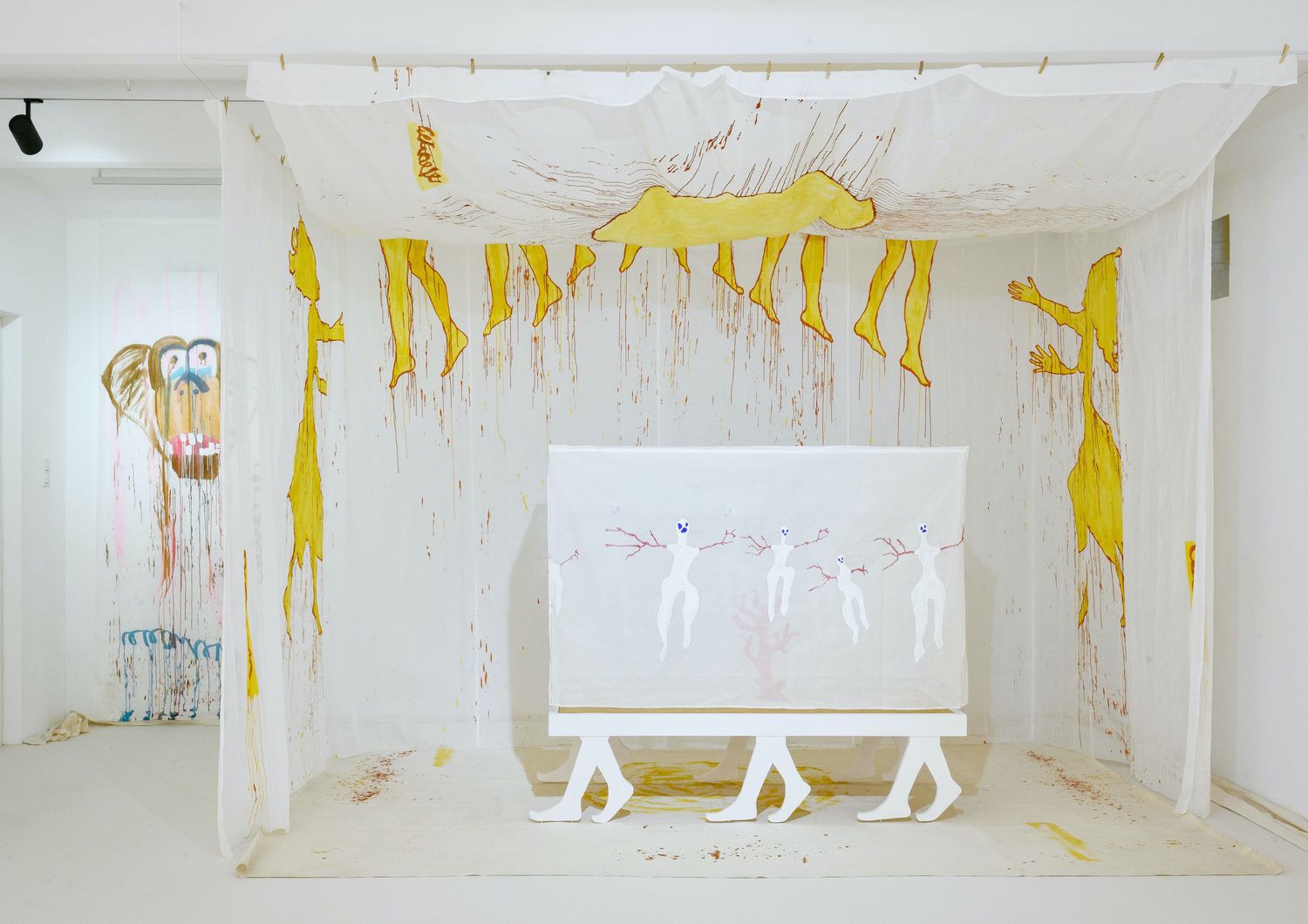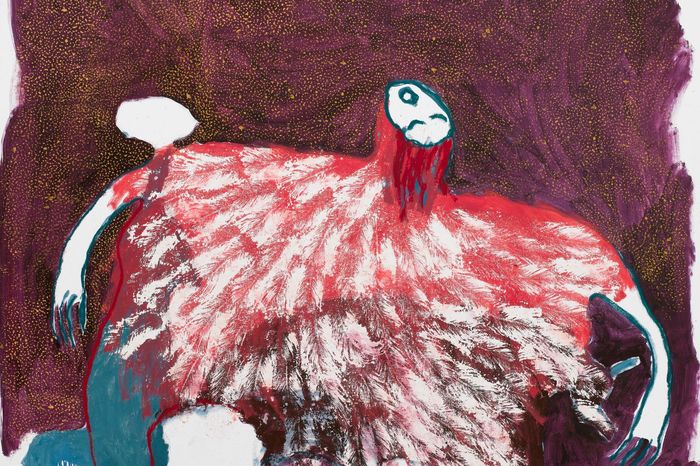Presence. The centrality of identity, expressed in creating something where nothing was before. The art of taking up space.
In the introductory video to her exhibition, Claudette Johnson states the motivation for her iconic portraits: “I wanted to tell a different story about our presence in this country.” ‘Our’, for Johnson, means the Black-British community, whom she has spent her career painting and uplifting. However, this idea of ‘presence’, of taking up space and thinking about the artistic spaces we inhabit, permeates throughout the Turner Prize 2024.
The Turner Prize was instituted in 1984 to serve as Britain’s foremost award for the visual arts. This year, on its 40th anniversary, Pio Abad, Jasleen Kaur, Delaine Le Bas and Claudette Johnson have all created extraordinary exhibits, each being worthy of an article in of itself. For the purposes of this one, however, a few pieces stand out most starkly.
PIO ABAD
Pio Abad’s exhibition, ‘To Those Sitting in Darkness’ functions as a satire, a starkly lit museum-esque space with artefacts laid out amongst the artist’s work to suggest the cold intellectualisation of colonial artist spaces. The single room is decorated with several cultural relics, such as traditional kris swords from Mindanao, the Philippines, wrapped Marawi woven fabrics, which adorn one wall.
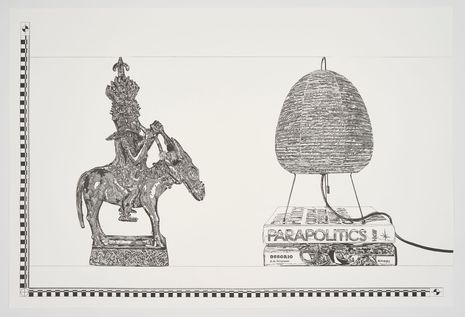
Abad integrates these historical artefacts with his own original creations. The artist has previously stated that “Objects are never from the past […] they always have a life that keeps on going, there’s always a story within them that continuously needs to be told.” In understanding ‘the artefact’ in this context, the art of the exhibition, in many ways, is in the interaction between these objects and Pio Abad’s original works. By situating the swords amongst Abad’s domestic items, the artist provides a recontextualisation which removes these relics from the ambiguously sterile environment of the museum and speaks to the “language and history of violence in things we take for granted.”
This is most striking in Abad’s series of drawings, titled, ‘1897.76.36.18.6, n.1 - 1897.76.36.18.6, n.14’, which comment on “the machinations of the museum.” The works are titled after mock acquisition numbers, pointing to how Abad is satirising anthropology and the obtainment of cultural artefacts. Each drawing depicts two objects, acquired under that number. On one side, a sketch of a Benin Bronze — one of the many controversial artefacts which has come to be emblematic of colonial exploitation — and on the other, domestic objects from Abad’s home. A Nutella pot. A small plant stacked on books. An ultrasound of the artist’s newborn daughter. The surreal contrast between the two objects in each drawing is comedic, but, as with all the best satire, this humour is deeply thoughtful. Abad stated that this series serves to remind the viewer that all relics — Benin Bronzes, jewellery, swords — are intimately tied to real people. They are evidence of people’s family history, and so, they are already domesticated items. The visual contrast we appreciate in his work, therefore, speaks less to the items themselves, but instead highlights the sanitising effect which the museum space has upon them. Relics are not just history, Abad is arguing: they are our history, they are us.
DELAINE LE BAS
In total contrast to Abad’s simplicity, Delaine Le Bas’ maximalist chaos is entirely devoid of the careful intellectualisation of the artist before her. Like jumping in cold water, her immersive rooms grab the viewer and drag them into the artist’s mournful world. Here, emotion is not stripped bare, but built up, ornamented, and worshipped.
“Emotion is not stripped bare, but built up, ornamented, and worshipped”
How can we make art when someone has died? Le Bas’ exhibition depicts the grief which followed her beloved grandmother’s death. Art spills from every inch in this exhibition, as sound, light, colour and fabric compete for the viewer’s attention. As you enter, the walls are draped in white organza, heavily layered, rolled, ripped and draped to reveal hidden, surreal, nightmarish sketches of warped flowers, angry faces, animals, and sums — grief at its most animalistic and potent. The emotion screams out from behind the soft, luminescent paper, and in the centre of the room, a paper heart sits on an altar, the beating, raw centre of the emotional experience.
From there, the work is a series of images: semi-reflective walls; the spidery legs of a horse, crouched in a dark corner; a projection of childhood footage, scratched over with thick black marker. As you progress into lighter space, the colours dim into pastel, the furious animals replaced by coral and an effigy to Medusa. The mourning, wronged woman of Greek culture, who must learn to live on.
It is a peculiar exhibition space to be in, but even more so to exit. Even now, I have come up with no resolution to the darkly immersive emotional intensity of Le Bas’ work, except to remember the cheery rhyme of her introduction video. In the face of everything, her name rings as if from a children’s tale, certain in the face of corrupting grief:
“‘Can you tell me who you are? ’
She does not hesitate: ‘Delaine Le Bas.’”
It is surely not an accident that the artist in this exhibition turns to the transcendental religious universe of Greek antiquity, where the bonds between the living and the dead are palpable, when the threshold between the underworld and the realm of the living could be crossed in both directions — Medusa, learning to live on.
JASLEEN KAUR
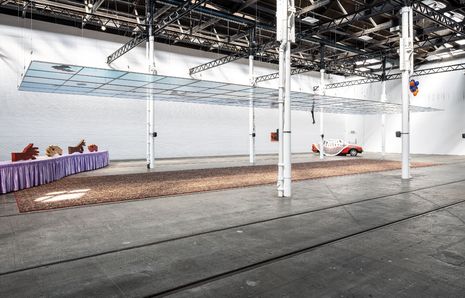
For a prize so focused upon ‘British’ identity, this year’s exhibition highlights the increasingly multi-faceted, complex and nuanced nature of such an identity, particularly as the exhibition sits in the centre of London’s metropolitan sprawl. Jasleen Kaur’s work speaks to her experiences within the Glasgow-Sikh community. As with Abad and Le Bas’ works, her art does not only reflect on multicultural identities, but rather it only exists at the rich interplay of multiple cultures. This multiplicity is exactly what Kaur is playing with in her work, as the centrepiece of her exhibition — a long carpet laid down through the room — refers to a place of worship, but also a living room. Alongside cassette tapes, Irn-Bru bottles, and photos of her family, she wonders how the ordinary is divine, how commercialism is tied up in faith. The slightly ambiguous space never commits to being one location, but, like Abad’s work, instead questions the interaction between the spaces we inhabit, and what they enact upon us. Kaur builds off post-colonial arguments about how we study history, as she wonders: ‘Who is doing the writing of history? Who is doing the retelling of it? ’, and settles on the view that, whoever it is, their version of history is a lot less honest. The truth, for Kaur, is much more ‘plural’.
“Kaur’s art only exists because of where she came from. In this way, her art is her”
Talking about her heritage, Kaur reflects on how her cultural past has brought her to her art, reminiscing over her childhood with her father, who works in a hardware store, and her ancestors, who were farmers in India. In conversation about her work with physical objects and immersive spaces, the artist asserts that her practicality is inherited: “somewhere, ancestrally, my body knows how to use [its] hands.” Kaur’s art only exists because of where she came from. In this way, her art is her. It is painted the colour of Irn-Bru, and sings Sufi music through the halls of the Tate.
CLAUDETTE JOHNSON
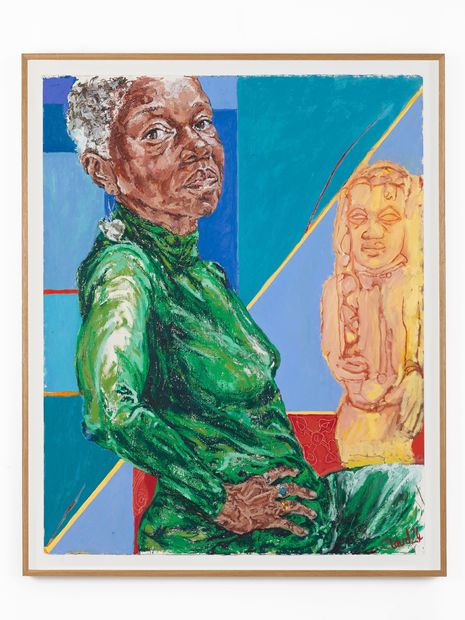
Emerging from Le Bas and Kaur’s immersive spaces into Johnson’s measured, more classical artistic space might be disatisfying, were it not for the brilliance of her vibrant, fluid portraits. Claudette Johnson was a founding member of the Black British Arts Movement in the 1980s, and is one of the most significant figurative artists of her generation. Now, forty years later, her exhibition celebrates the achievements of her long, decorated career. If, in Le Bas’ work, distortion was the subject of her exhibition, Johnson’s portraits are starkly present and clear. The portraiture challenges biases about Black womanhood in British portraiture, through which Johnson states her identity has been “distorted, hidden, and denied.” Clear, vibrant colours create tangible, fluid presences in oil pastel, watercolour and gouache. Her large-scale portraits decorate empty space with geometric bright colours, like deep jewel-toned greens, and vibrant complementaries: in Johnson’s work, the British-Black community is taking up its rightful space. The natural curves of the sitters cut through the harsh geometric backgrounds, carving out space for themselves within the frame.
The room ends with a large, white wall, interrupted by a small, unassuming self-portrait, ‘Self Study 2’, which draws the eye with its more densely-drawn, and vibrantly pigmented oil pastel. The thickly-drawn pastel is textured, like real skin upon the canvas. It’s Johnson, the only self-portrait in the room, in total contrast to the large-scale celebrations adorning the walls behind her. Her head is angled towards the exit to her left. A nod goodbye from one of the most influential British artists of the late 20th and early 21st centuries, perhaps. As I exited, I felt distinctly mournful to be leaving that carved out space — that presence, and how it has been shared.
The Turner Prize Exhibition is open until February 16th 2025, at the Tate Britain, London. The winner will be announced on December 3rd, 2024.

